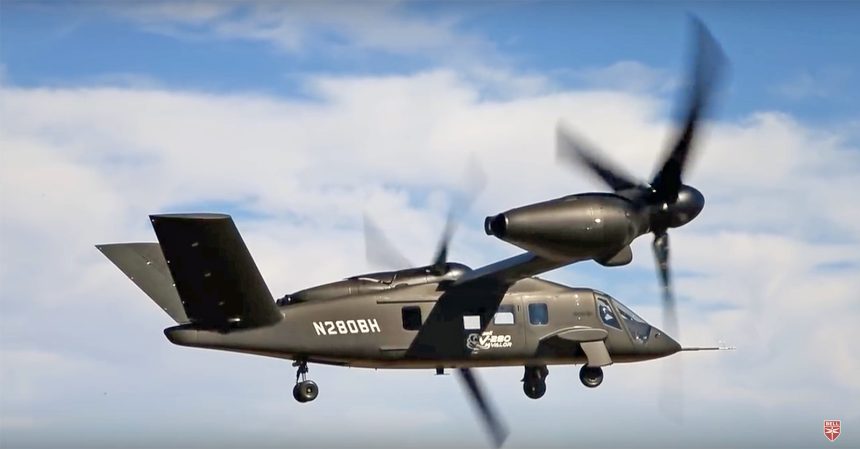Second Milestone in 30 Days as New Light Tiltrotor Progresses to Max Speed Test.
Bell’s V-280 Valor light tiltrotor aircraft has flown in level flight with its tiltrotors in the horizontal/cruise mode for the first time this week. The aircraft reached 190 knots (218 MPH) during the flight.
The new Bell V-280 Valor is a medium, tactical tiltrotor aircraft designed for the U.S. Army Joint Multi-Role Technology Demonstrator (JMR-TD) program. The JMR-TD program is a precursor for the Army’s overall Future Vertical Lift (FVL) co-development and evaluation of possible replacements for existing rotorwing aircraft in five different roles. The V-280 Valor is a proposed candidate for a new JMR-Medium utility and attack helicopter to potentially replace the UH-60 Blackhawk utility helicopter and the AH-64 Apache attack helicopter.
The Bell V-280 is reportedly capable of a maximum speed of 280 knots or 322 MPH, hence the name “V-280”. That is significantly faster than the U.S. Army’s existing UH-60 Blackhawk helicopters’ maximum speed of 192 knots or 222 MPH and nearly as fast as the MV-22 Osprey tiltrotor aircraft with a top speed at sea level of 305 knots or 351 MPH according to Bell Boeing.
The V-280 Valor is intended to carry up to 14 troops in a tactical personnel transport configuration with a crew of four including two flight crew and two gunner/loadmasters. It may also be developed with the capability to be an attack helicopter with various weapons onboard as depicted early in the program in a concept video showing an animated assault on a high altitude insurgent camp during hot weather. High altitude/hot weather flight conditions, called “High and Hot”, are challenging for most existing rotor wing aircraft. The V-280 will be optimized for high and hot operations.
While similar in visual configuration to the existing V-22 Osprey tiltrotor in service with the U.S. Air Force and U.S. Marines, the V-280’s engines remain in a fixed position on the wing while only the tiltrotors change geometry from vertical flight to horizontal flight. One advantage to this system is that both tiltrotors on the V-280 can operate off a single engine. On the V-22 Osprey both of the entire engine nacelles rotate during the transition from vertical to horizontal flight and the engine drive systems are fully segregated from each other, but joined by a complex gear box so the aircraft can operate on one engine.

Another unique feature of the V-280 Valor is the one-piece carbon fiber composite wing section. The one-piece composite wing uses Large Cell Carbon Core technology, reducing costs by over 30% compared to the construction of the V-22 Osprey wing. The one-piece wing is also integral to the ability of the twin tiltrotors to operate off power from only one engine if needed.
The Bell V-280 Valor competes with the Sikorsky-Boeing SB-1 Defiant aircraft in the JMR-TD program. The SB-1 Defiant uses two contra-rotating rotors and a “pusher” style tail rotor in a more traditional helicopter configuration as compared to the Bell V-280 tiltrotor design.
As the V-280 program advances through flight testing the aircraft has now flown 27 hours with approximately 90 hours of time turning the rotors in ground and flight tests. The aircraft has demonstrated its ground taxi and hover capability as well as low-altitude maneuvers including 360-degree pedal turns and forward/aft/lateral repositions along with 60 knot roll-on landings.
The next phase of flight operations for the V-280 will include maximum speed flights scheduled for some time within the next 90 days according to Bell. “During the summer, we plan on reaching most of the required performance parameters that were part of the test program,” said Jeffrey Schloesser, Bell’s executive vice president of strategic pursuits, during an interview last month with Aviation Week.
An interesting part of the advancements in the test program is that now the Bell V-280 is accompanied during test flights by an Aero L-39 jet chase plane because of the V-280’s increasing speed in testing.









